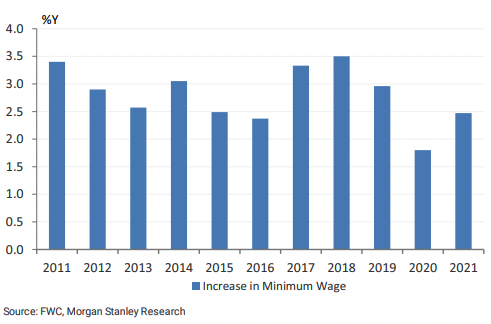Why Australia's latest jobs report may not gift a big rate hike in June
Roll up, roll up, we have yet another labour force surprise. But it's not the surprise we are used to.
The good news? For the first time since 1974, unemployment is below four percent.
The bad news? The economy lost 88,000+ part-timers in the last month which meant the actual number of jobs created was just 4,000. Cost pressures are clearly biting and that may be coming through in the number and the kind of jobs that are being created. With skills and human shortages still persisting, it's not exactly going to be easy.
Couple that with Wednesday's Q1 wage price index which registered a 2.4% year-on-year print and what have you got?
A fully employed labour market.
With an election looming and two key reads on the economy's health missing expectations, we are now at a fork in the proverbial road. This wire will tackle the options - and more importantly, what might actually happen as a policy response to fix it.
An admission of guilt
Here in Sydney's high streets, I counted no less than five shops, cafes, and bars that had Help Wanted signs in the window this past weekend. Acknowledging this, the RBA left this cheeky note in their minutes released earlier this week:
An argument for an increase of 40 basis points could be made given the upside risks to inflation and the current very low level of interest rates.
So not only can it not be ruled out now, it actually was a serious contender at the meeting held earlier this month.
The economists have already been out on the march - with some like Andrew Ticehurst at Nomura noting that the sole thing stopping the board was the election campaign.
We think the option of delivering a “normal” 25bp hike, in the midst of a heated election campaign, was likely the easiest. Still, we do not discount the possibility of a larger move in the future and continue to think a 40bp hike in June is most likely.
Expectations versus reality
But what the market thinks the RBA will do and what they will actually do are two very different beasts. Nomura is a relative outlier, with Citi, UBS, and Morgan Stanley all expecting 25 basis point hikes on the first Tuesday in June.
Citi's base case in particular is of interest - given the crux of their argument is the lack of a wage-price spiral in Australia. This is in spite of the fact that real wages are the lowest on record and that a larger-than-expected change to the minimum wage is still a very real possibility:
There is no evidence of a US-style wage-price spiral occurring in Australia, and with the RBA already embarking on a tightening policy, we don’t see wages growth rising beyond high-3% over the forecast horizon.
Analysis - Frank Uhlenbruch, Janus Henderson Investors
Neither release, in Frank's view, has provided an obvious smoking gun for a 40bps move. But there is no doubt in his mind that both releases support the view that the labour market is tight.
"We expect the RBA to tighten consecutively at its next three meetings, with a 40bps move on the cards in response to either a strong lift in the minimum wage at the next Fair Work Commission hearing or strong Q2 CPI print," Frank says.
"While now is the time to steadily normalise the cash rate and anchor longer-term inflation expectations, market pricing for a 2.6% cash rate at the end of the year and close to 3.5% towards the end of 2023 seems too aggressive and runs the risk of tipping the economy into an unnecessary recession."
The final chart
My final chart to leave you with comes from Morgan Stanley and it refers to the minimum wage debate that I mentioned earlier. The last ten years have seen annual adjustments of between two percent and 3.5% mostly (bar 2020) - but that was also given the fact that inflation was not where it is today.

As mentioned at the beginning of this piece, the number of people actively looking for work hasn't changed all that much.
However, the culling of so many part-time jobs may demonstrate how rising costs are impacting employers' ability to keep staff on their books.
It could also be a far simpler explanation - people are just leaving part-time work for full-time work. Either way, the great lottery that is the labour force continues. And it really is a lottery.
Never miss an insight
If you're not an existing Livewire subscriber you can sign up to get free access to investment ideas and strategies from Australia's leading investors.
I'll be in charge of asking the questions to Australia's best strategists, economists, and fixed income fund managers. If you have questions of your own, flick us an email: content@livewiremarkets.com
5 topics

